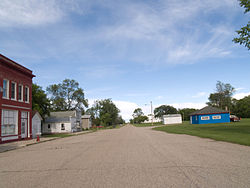Monango, North Dakota
Monango is a city in Dickey County, North Dakota, United States. As of the 2020 census, 30 people lived there.[3]
Monango, North Dakota | |
|---|---|
 Street in Monango | |
 Location of Monango, North Dakota | |
| Coordinates: 46°10′24″N 98°35′43″W / 46.17333°N 98.59528°W | |
| Country | United States |
| State | North Dakota |
| County | Dickey |
| Founded | 1886 |
| Area | |
| • Total | 0.38 sq mi (0.98 km2) |
| • Land | 0.38 sq mi (0.98 km2) |
| • Water | 0.00 sq mi (0.00 km2) |
| Elevation | 1,509 ft (460 m) |
| Population | |
| • Total | 30 |
| • Density | 79.58/sq mi (30.74/km2) |
| Time zone | UTC-6 (Central (CST)) |
| • Summer (DST) | UTC-5 (CDT) |
| ZIP code | 58436 |
| Area code | 701 |
| FIPS code | 38-53820 |
| GNIS feature ID | 1036168[2] |
History
changeMonango was founded in 1886.
Geography
changeMonango is located at 46°10′21″N 98°35′38″W / 46.17250°N 98.59389°W (46.172520, -98.593856).[4]
According to the United States Census Bureau says that the city has a total area of 0.38 square miles (0.98 km2). All of it is land.[1]
Demographics
change| Historical population | |||
|---|---|---|---|
| Census | Pop. | %± | |
| 1910 | 238 | — | |
| 1920 | 231 | −2.9% | |
| 1930 | 211 | −8.7% | |
| 1940 | 175 | −17.1% | |
| 1950 | 138 | −21.1% | |
| 1960 | 133 | −3.6% | |
| 1970 | 112 | −15.8% | |
| 1980 | 59 | −47.3% | |
| 1990 | 53 | −10.2% | |
| 2000 | 28 | −47.2% | |
| 2010 | 36 | 28.6% | |
| 2020 | 30 | −16.7% | |
| U.S. Decennial Census[5] 2020 Census[3] | |||
2020 census
changeAs of the 2020 census, there were 30 people, 12 households, and 7 families living in Monango. The racial makeup of the city was 76.7% White and 23.3% from two or more races. The median age in the city was 26 years.[3][6]
2010 census
changeAs of the 2010 census says that there were 36 people, 14 households, and 7 families living in the city.[7] The population density was 97.3 inhabitants per square mile (37.6/km2). There were 22 housing units at an average density of 59.5 per square mile (23.0/km2). The racial makeup of the city was 86.1% White and 13.9% from two or more races.
There were 14 households of which 35.7% had children under the age of 18 living with them, 50.0% were married couples living together, and 50.0% were non-families. 21.4% of all households were made up of individuals and 7.1% had someone living alone who was 65 years of age or older. The average household size was 2.57 and the average family size was 3.00.
The median age in the city was 32 years. 30.6% of residents were under the age of 18; 8.3% were between the ages of 18 and 24; 22.3% were from 25 to 44; 22.3% were from 45 to 64; and 16.7% were 65 years of age or older. The gender makeup of the city was 44.4% male and 55.6% female.
2000 census
changeAs of the 2000 census says that there were 28 people, 14 households, and 7 families living in the city. The population density was 76.7 people per square mile (29.2/km²). There were 18 housing units at an average density of 49.3 per square mile (18.8/km²). The racial makeup of the city was 100.00% White.
There were 14 households out of which 21.4% had children under the age of 18 living with them, 35.7% were married couples living together, 7.1% had a female householder with no husband present, and 50.0% were non-families. 50.0% of all households were made up of individuals and 28.6% had someone living alone who was 65 years of age or older. The average household size was 2.00 and the average family size was 2.86.
In the city, the population was spread out with 25.0% under the age of 18, 3.6% from 18 to 24, 25.0% from 25 to 44, 17.9% from 45 to 64, and 28.6% who were 65 years of age or older. The median age was 43 years. For every 100 females, there were 86.7 males. For every 100 females age 18 and over, there were 110.0 males.
The median income for a household in the city was $11,250, and the median income for a family was $28,750. Males had a median income of $32,500 versus $30,625 for females. The per capita income for the city was $15,652. There were 50.0% of families and 17.4% of the population living below the poverty line, including no under eighteens and 36.4% of those over 64.
References
change- ↑ 1.0 1.1 "2020 U.S. Gazetteer Files". United States Census Bureau. Retrieved July 24, 2022.
- ↑ 2.0 2.1 U.S. Geological Survey Geographic Names Information System: Monango, North Dakota
- ↑ 3.0 3.1 3.2 3.3 "Profile of General Population and Housing Characteristics: 2020 Demographic Profile Data (DP-1): Monango city, North Dakota". United States Census Bureau. Retrieved February 19, 2024.
- ↑ "US Gazetteer files: 2010, 2000, and 1990". United States Census Bureau. February 12, 2011. Retrieved April 23, 2011.
- ↑ United States Census Bureau. "Census of Population and Housing". Retrieved February 2, 2014.
- ↑ "P16: HOUSEHOLD TYPE". United States Census Bureau. Retrieved February 19, 2024.
- ↑ "American FactFinder". United States Census Bureau. Retrieved June 14, 2012.